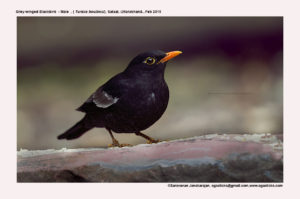Grey-winged Blackbird

Grey-winged Blackbird Turdus boulboul
Etymology:
- Turdus : Latin word for Thrush
- Boulboul: Persian Bulbul bulbul, the nightingale of the east.
Vernacular Names: Hindi: Kasturi, Pun: Saleti par kasturi, Ben: Pahariyamasaicha, Lepcha: Phoyiong-pho, Bhutan: Chemam
Distribution in India: Resident of Himalayas and winter visitor in North East India.
Description: Size of 20-21 cm. The male is black, with broad pinkish-grey wingpanel, whitish-tipped wing-coverts and vague greyish scaling on lower underparts. It has a yellow bill and narrow eyering and yellowish-brown legs. The female is pale olive-brown and has warm brown wing-coverts with broad pinkish-buff tips. The juvenile is dark brown with buff spots and streaks above, buff-brown with narrow dark bars below, plain wingpanel greyer on male, buffier on female.
Habitat: It breeds in diverse humid oak and other broadleaf evergreen forests. It is found from 800–2700 m in Himalayas.
Food habits: It eats Insects, including a high proportion of larvae, ground-feeding caterpillars, also snails, slugs, earthworms and fruits and berries. It is often an arboreal feeder, seeking invertebrates in moss on boughs. It also forages on ground in typical turdine manner, with rapid hops and pauses. It is seen often in small flocks in winter.
Breeding habits: They breed in Mar–Aug and often double-brooded. The nest is flimsy or bulky, sometimes mud-lined cup decorated externally with moss and lichen and lined with hair, fern stems and fine rootlets, usually on branch close to main stem up in tree, sometimes on ground among roots or rocks. They lay a clutch of 2-4 eggs. The female incubates the eggs, while the male feeds the female in the nest. Both the parents feed the chicks.